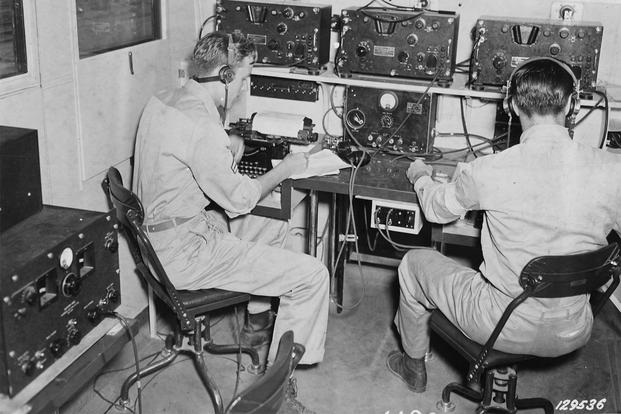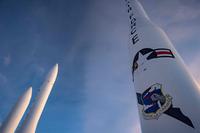My name is Edward A. Dunton. I was born Oct. 9, 1917, in Mason City, Iowa. In 1942, I was commissioned an ensign in the Naval Reserve. I was ordered to active duty on Dec. 21, 1942, and was instructed to report to the Naval Training School (Communications) at Harvard University, Cambridge, Massachusetts.
Training at the Naval Communications School covered all phases and types of ship and shore communications, with particular emphasis on codes and ciphers. I finished training there on May 27, 1943, at which time I was ordered to report to the pre-commissioning detail of the USS Swift (AM 122) in Camden, New Jersey.
The Swift was 220 feet long with a 36-foot beam and was a dual purpose ship with a crew of about 108 officers and men. Our main mission was to sweep ahead of the major fighting ships of the fleet, battleships, cruisers, destroyers and so on. For this work, we were equipped to sweep moored mines, magnetic mines and acoustic mines. In the Normandy invasion, we came up against a so-called "pressure" mine that we did not know how to sweep. But that is another story.
Our second purpose was to serve as a convoy escort ship and as a ship screening invasion areas or other sensitive areas against both submarines and surface ships. We had all the anti-submarine weaponry of a destroyer -- that is, depth charges, K guns and a new anti-submarine weapon called a hedgehog, which fired a number of projectiles, about 12-18 simultaneously, ahead of the ship in an elliptical pattern and which exploded only on contact.
My rank during the events described herein was lieutenant (JG). The highest rank I achieved was lieutenant, and I was returned to inactive duty -- that is, released from active duty -- on Jan. 17, 1946. My last duty dating from June 1945 was studying Japanese language at a Naval Training School in Stillwater, Oklahoma, preparing for the invasion of Japan.
My duties on the USS Swift were to serve as communications officer and one of the three officers of the deck when the ship was underway. The officer of the deck is in control of the ship during his four-hour "watch," and for 24 hours a day, one of the three of us was always on "watch." The captain, of course, could assume control of the ship at his discretion, and always did during actual combat, being careful to state "Mr. -- I relieve you." It was important that there be no misunderstanding as to who was in charge of the ship.
Our first major assignment was to escort Convoy NY78 from New York to Plymouth, England. We left New York on March 25th, 1944, arriving in Plymouth 26 days later on April 19, 1944. The reason the voyage took so long was that a considerable part of the convoy consisted of a dozen or more ocean-going tugs, each towing two long, oblong objects, mostly submerged. These objects, I believe, became part of the Mulberry Artificial Harbors constructed off the Normandy beaches following D-Day.
Only two memorable events occurred in our crossing the Atlantic; one was the sinking of one of the tugs on April 12, 1944. She sank in heavy seas during the night, not from enemy action, but because the seas just overwhelmed her. As she was sinking, the convoy commander ordered about six of the escort ships, including the USS Swift, to surround the tug and rescue its crew. Contrary to standard doctrine, we all turned on our powerful searchlights, making the area as bright as day. We rescued the entire crew, did not attract enemy submarines, and then sank the tug and the objects she was towing by gunfire.
On April 16, 1944, we received a message from Admiralty (British Navy Headquarters) warning us that we would probably be intercepted by German submarines within the next 24 hours. I feel certain our lighting up the north Atlantic two days earlier attracted enemy attention. Sure enough, at 16:25 on the afternoon of April 17, the escort ships made contact with submarines and engaged them with depth charges, hedgehogs, K guns and all the weaponry we had. The USS Swift sank one of the submarines by hedgehog fire, but we did not receive credit for the sinking until after the war, when the Navy reviewed German naval records and compared them to records of U.S. Navy ships.
I should say parenthetically at this point, that I am precise on details because I went to the U.S. Archives and reviewed the logs of the Swift for the critical days of which I am writing. The logs by that time (the 1980s) had been declassified and made available for inspection. I should say that I am the last surviving officer of the Swift, the captain and the engineering officer, two of the senior officers, having died within the last five years.
Our activities during May 1944 consisted of practicing mine sweeping, usually at night, off the southern coast of England preparing for D-Day. The first five days of June 1944, we were aboard ship, all ships having been sealed on June 1. We spent our time studying invasion plans, communications plans, the disposition of German guns, tanks and infantry, etc.
We also conducted fire drills, damage control drills and other types of contingency activities. I particularly recall daily drills requiring the use of gas masks and protective clothing, because it was widely expected the Germans would use poison gas against us. [On] June 4, we got underway from Plymouth, England, heading for Baie de la Seine, but as everyone knows, we were called back because of bad weather. D-Day was postponed one day.
On June 5, we got underway at 06:10 from Torquay, England, where we had anchored after being called back from the first invasion attempt. And again our destination was Baie de la Seine, France, the invasion area. We were part of Task Force 125, the assault force for Utah Beach, a mighty force of about 100 minesweepers, 100 bombardment ships and 200 landing craft. At 17:45 on June 5, I took over as officer of the deck, from my friend, Lt. Bill Ross. At this time, we were part of what Professor [Stephen] Ambrose calls in his book "D-Day," "the long endless column of ships."
It is here that I can, with confidence, offer a minor correction to page 254 of Professor Ambrose's book. He writes, "the Osprey hit a mine at about 1700 on June 5th." USS Osprey was one of the ships of our division, 18th Minesweepers, in company with us. I had, as I said, just taken over as officer of the deck at 17:45 hours and was looking around the convoy, determining where ships were located, whether we had the proper distance between ships and so on.
The Osprey was on our port quarter, and the Swift's log reveals that at "17:57 the Osprey was damaged by an underwater explosion." At that time, I was looking right at her, but I had no idea whether she had been hit by a torpedo or a mine, and I instantly sounded general quarters. We stayed at general quarters for 36 hours, the night of June 5 and the entire day of June 6.
At 23:31 on June 5, we streamed our sweeping gear to sweep moored mines. We swept the fire support channel; that is, the channel leading to the fire support area where the battleships, cruisers and destroyers were to be stationed and in which they were to maneuver while bombarding Utah Beach. We recovered our sweep gear about 03:00 hours, and no sooner had we done so, having swept out the fire support area, than the battleships, cruisers and destroyers silently glided into the area and prepared for their bombarding duties, which started, as I recall, around 4:30 a.m. One of my clearest recollections is my amazement at how precisely events mirrored plans.
During the day of June 6, we swept many parts of the invasion area, sweeping much of the time ahead of the USS Nevada, a battleship; every time she fired, it seemed to me the Swift rolled about 20 degrees to port or starboard. We swept during the entire day, and at 20:38 on June 6, we anchored as ordered in eight fathoms of water in the Baie de la Seine, part of an anti-E Boat and anti-submarine screen, protecting the invasion area. D-Day, one of the most exciting, if not the most exciting and memorable day of my life, was over.
My only recollections with respect to crossing the channel was that everyone was very serious and quiet, except for some grim humor because of the high quality of the meals the stewards and cooks made and served during the day of June 5. We all wore two life preservers, a belt type and the so-called "Mae West" life jacket.
During the night of June 6, German planes flew overhead dropping magnetic mines. It was for that reason on the morning of June 7, while we were sweeping magnetic mines in company with the USS Tide, that the Tide suffered tremendous damage and heavy casualties from a magnetic mine. She broke in two very quickly and sank even before the boarding party we sent to her to rescue survivors could be sure they had reached them all, and before we could get the two halves of the ship clear of the channel for incoming ships.
Although we remained in the invasion area for another two weeks, trying to sweep all the mines the Germans had placed, and continued to sow, the work became deadly routine. No experience of mine is remotely comparable to the events of June 5-6, when the planes, ships and men of the "Mighty Armada" started the downfall of the Third Reich.
Want to Know More About the Military?
Be sure to get the latest news about the U.S. military, as well as critical info about how to join and all the benefits of service. Subscribe to Military.com and receive customized updates delivered straight to your inbox.













